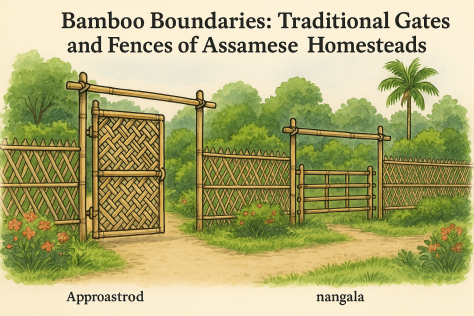
Introduction
In the verdant landscape of Assam, where nature and tradition harmoniously blend, even the most utilitarian structures like fences and gates reflect a deep-rooted cultural aesthetic. One of the most iconic features marking the entrance to a traditional Assamese homestead is the bamboo gate—beautifully simple yet ingeniously crafted. These gates are not just barriers; they are statements of identity, craftsmanship, and a way of life that honors sustainability.
The Traditional Bamboo Gate
The entrance gate, usually located at the boundary of the approach road to the house, is predominantly made using bamboo—an abundant and versatile material in the region. Traditional Assamese gates vary in type and construction but are united by their functional elegance and eco-friendly nature.
Woven Bamboo Fence Gates
The most common type of gate is a woven bamboo lath fence, or kami, bordered with intricately laced pairs of bamboo strips known as japana. These gates come in various operational styles:
- Swinging Gates: A simple mechanism where one side of the gate is loosely tied to a post using a rope, allowing it to swing open when pushed.
- Revolving Gates: In this variant, the laced edge of the gate is inserted into a bamboo capping, with one end protruding. This protrusion fits into a socket made from another bamboo internode embedded in the ground, allowing the gate to rotate within it. For bi-folded gates, this system is applied on both ends.
- Sliding Gates: These gates slide horizontally using bamboo tracks. One version uses inserted bamboo pieces to form a sliding channel at the base. Another innovative design involves overhead bamboo loops or pulleys that suspend the gate and allow it to glide along a top-mounted bamboo rod.
Nangala: The Horizontal Slide Gate
Another notable variety is the nangala, also called kharkabari, salakhabari, harkala, or halkala. This traditional gate operates by horizontally sliding bamboo rods through holes in vertical bamboo posts.
To build a nangala, two hollow bamboo posts—preferably of the bhaluka species—are erected, each around 5 to 6 feet tall. These posts are notched just above the node to form holes, allowing horizontal bamboo rods to pass through. The rods can then be pushed or pulled to open or close the entrance. It’s a beautifully rudimentary locking mechanism that reflects both efficiency and rustic charm.
The Approach Road and Surroundings
The entrance is just one part of the carefully curated aesthetic. The approach road leading to the homestead is often fenced with shiyaltati, a diagonally woven bamboo fence capped with straight bamboo poles. This serves both decorative and protective purposes.
Lining the inner side of the fence are flowering bushes, ornamental shrubs, and occasionally coconut palms, contributing to a serene and welcoming environment. The broader landscape around the road often includes a kitchen garden, providing vegetables and herbs for the household—another testament to the self-sufficient rural lifestyle.
Conclusion
The gates and fences of Assamese homesteads are far more than functional boundaries. They represent a vernacular architecture shaped by the land, material availability, and generational craftsmanship. In a time when modern materials are often favored, these bamboo structures stand as enduring symbols of sustainable living and cultural pride.

Comments (0)
To comment, please Login